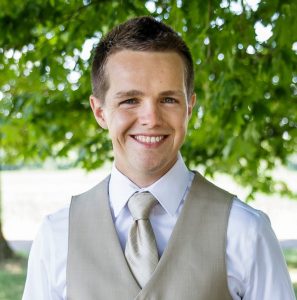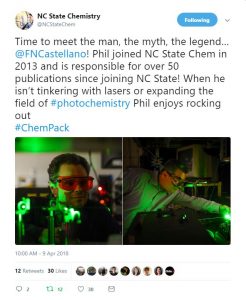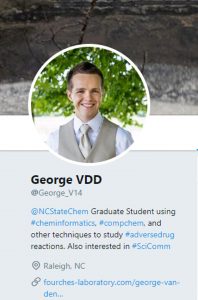 The Nifty Award is given by the Leadership in Public Science cluster, to recognize ambitious and well-designed activities by members of the NC State community that put publics at the center of science.
The Nifty Award is given by the Leadership in Public Science cluster, to recognize ambitious and well-designed activities by members of the NC State community that put publics at the center of science.
The award for Fall semester, 2018, goes to George Van Den Driessche for his creative work profiling NCSU Chemistry researchers on Twitter. We asked George to share some of his social media wisdom in the interview below.
How did you get from “using a combination of Cheminformatics and Quantum based techniques to model and predict adverse drug reactions” to Twitter maven?
Denis Fourches (@DFourches) encourages all the students in his group to have active social media accounts to promote publications from the lab. I quickly realized the importance of promoting our work through press releases and social media (like Twitter and LinkedIn) after the high visibility my first publication gained from these platforms. This first study has been viewed over 2,390 times and cited 5 times, to date, and I believe our use of press releases and social media is a major factor in its success. My first paper was about developing a quick virtual screening tool to predict a drug’s ability to bind with immune-signaling human leukocyte antigen (HLA) proteins. This binding incidence results in mild to serious adverse drug reactions in patients and is extremely difficult to predict. Our model provides a tool to forecast a drug’s theoretical ability to bind with the HLA-B*57:01 variant. (J. Cheminfo 2017, DOI:10.1186/s13321-017-0202-6).
Tell us about your Twitter lab profiles–what are your goals for them, and how hard are they to pull off?
 In the Fall 2017 semester, I had just taken over the NC State Chemistry Graduate Student Association’s social media accounts (@NCStateChemGSA) and was routinely promoting department events and announcements. Then I had the idea to start creating monthly collections of NC State chemistry department news (publication announcements, student defenses, etc.) into Twitter moments. A Twitter Moment is a collection of Tweets that share a central theme; almost like a miniature news story. While I was creating these Moments, I started to notice how difficult it was to learn about the research of labs not on social media. Around that same time, Maria Gallardo-Williams (@teachforaliving), and Gavin Williams (@ChemBioSynth), who jointly manage the chemistry department account (@NCStateChem), noticed my work and we began having conversations about how to increase the department’s social media presence. Then #ChemPack was born.
In the Fall 2017 semester, I had just taken over the NC State Chemistry Graduate Student Association’s social media accounts (@NCStateChemGSA) and was routinely promoting department events and announcements. Then I had the idea to start creating monthly collections of NC State chemistry department news (publication announcements, student defenses, etc.) into Twitter moments. A Twitter Moment is a collection of Tweets that share a central theme; almost like a miniature news story. While I was creating these Moments, I started to notice how difficult it was to learn about the research of labs not on social media. Around that same time, Maria Gallardo-Williams (@teachforaliving), and Gavin Williams (@ChemBioSynth), who jointly manage the chemistry department account (@NCStateChem), noticed my work and we began having conversations about how to increase the department’s social media presence. Then #ChemPack was born.
The #ChemPack lab profiles began as a tool to start showcasing the great research (and teaching) faculty of the department. Each feature begins by introducing the lab being highlighted, then a brief bio about the lab’s principal investigator, and concludes with several Tweets showcasing the students in the group and their research projects.
Our first feature was the Castellano Lab (@TheCastellanoLab) and that was the most difficult #ChemPack feature to execute (visit the Twitter moment here.) The challenge with this first feature was determining what these features should look like, but once I visited the lab a few times and started talking with Dr. Castellano and his students it started to shape itself. Our next two showcases, the Williams Lab and the Sombers Lab, were easier to execute because we had a template to follow from the first feature. The next #ChemPack feature will be the Fourches Lab.
Effective social media takes more than just pushing out regular tweets (although it does take that). What tips do you have for increasing impact?
 I think one of the easiest things you can do to increase your outreach on Twitter is to update your Twitter profile to include the handle to your university (or department or work) and a short description of your interests. This will increase your searchability (anyone who searches for your university department will easily find you now) and clearly tells other Twitter users what your profile is about. The second thing is to start including images, videos, or GIFs with your tweets. We are a visual society, so it should not be surprising that tweets containing images have more engagement. Third, when you are starting out using the right hashtag makes all the difference. Twitter doesn’t rely as heavily on hashtags anymore, but they are an effective tool for pooling tweets and creating a community. Some hashtags I follow for chemistry (and cheminformatics) are #CompChem, #Cheminformatics, #RealTimeChem, #ChemTwitter, and #ChemJobs. I also follow #SciComm.
I think one of the easiest things you can do to increase your outreach on Twitter is to update your Twitter profile to include the handle to your university (or department or work) and a short description of your interests. This will increase your searchability (anyone who searches for your university department will easily find you now) and clearly tells other Twitter users what your profile is about. The second thing is to start including images, videos, or GIFs with your tweets. We are a visual society, so it should not be surprising that tweets containing images have more engagement. Third, when you are starting out using the right hashtag makes all the difference. Twitter doesn’t rely as heavily on hashtags anymore, but they are an effective tool for pooling tweets and creating a community. Some hashtags I follow for chemistry (and cheminformatics) are #CompChem, #Cheminformatics, #RealTimeChem, #ChemTwitter, and #ChemJobs. I also follow #SciComm.
The fourth (and best) way to increase your impact is to have a genuine voice. This also happens to be the hardest and the one I am struggling with the most. There are so many accounts out there who are only liking and retweeting content that you need to have a special X-factor to stand above the noise. That X-factor is your voice, the tool that makes your account human. Instead of just retweeting an article, take a few minutes to read the article and add your own views to the content. In other words, you need to create something that will make people want to follow you.
What role do you see public communication of science playing in your career?
I hope science communication plays a huge role in my career! My favorite part about science communication is meeting a diverse group of scientists, learning about the impacts of their research, and sharing their passion for discovery with people outside the scientific community! One example is the opportunity I had to sit down with David Muddiman and discuss NC State’s new Molecular, Education, Technology, and Research Innovation Center (METRIC). METRIC is a core instrumentation facility that combines departmental research equipment into one parent facility.
Science communication is extremely important for any scientist in any discipline. If we don’t invest the time and energy to communicate with the public now, then they won’t care about investing in science later. That means we need to use all of the communication tools available (press releases, social media outlets, or whatever the future holds) to promote the work we are doing today.